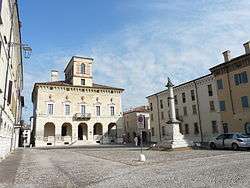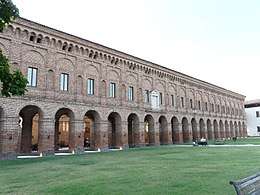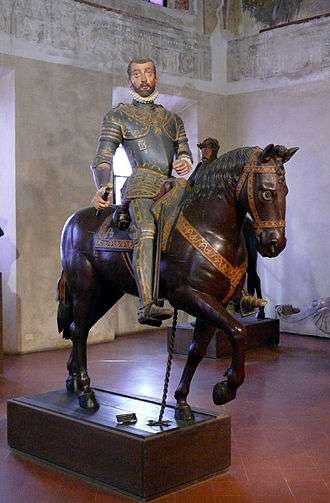Sabbioneta
| Sabbioneta Subiùnèda (Emilian) | |
|---|---|
| Comune | |
| Comune di Sabbioneta | |
 Piazza Ducale | |
 Sabbioneta Location of Sabbioneta in Italy | |
| Coordinates: 45°00′N 10°29′E / 45.00°N 10.49°ECoordinates: 45°00′N 10°29′E / 45.00°N 10.49°E | |
| Country | Italy |
| Region | Lombardy |
| Province | Mantua (MN) |
| Frazioni | Breda Cisoni, Ca' de Cessi, Commessaggio Inferiore, Ponteterra, Villa Pasquali |
| Government | |
| • Mayor | Antonio Beccari |
| Area | |
| • Total | 37 km2 (14 sq mi) |
| Elevation | 18 m (59 ft) |
| Population | |
| • Total | 4,260 |
| • Density | 120/km2 (300/sq mi) |
| Time zone | UTC+1 (CET) |
| • Summer (DST) | UTC+2 (CEST) |
| Postal code | 46018 |
| Dialing code | 0375 |
| Patron saint | San Sebastiano |
| Saint day | 20 January |
| Website | Official website |
| UNESCO World Heritage site | |
| Part of | Mantua and Sabbioneta |
| Criteria | Cultural: (ii)(iii) |
| Reference | 1287-002 |
| Inscription | 2008 (32nd Session) |
| Area | 60 ha (150 acres) |
| Buffer zone | 430 ha (1,100 acres) |

Sabbioneta (Casalasco-Viadanese: Subiùnèda) is a town and comune in the province of Mantua, Lombardy region, Northern Italy. It is situated about 30 kilometres (19 mi) north of Parma, not far from the northern bank of the Po River. It was inscribed in the World Heritage List in 2008.
History
Sabbioneta was founded by Vespasiano I Gonzaga in the late 16th century along the ancient Roman Via Vitelliana, on a sandy bank of the Po (whence the name, meaning "Sandy" in Italian); he was its first duke, using it as a personal fortress and residence.
It was also during this period that it became a minor musical centre; composers such as Benedetto Pallavicino (c. 1551-1601) were employed here by Vespasiano Gonzaga, prior to his moving to the main Gonzaga city of Mantua.

Main sights
In 2008, Sabbioneta was inscribed in the UNESCO World Heritage List as a recognition of its perfect example of practical application of Renaissance urban planning theories.
Sabbioneta is also known for its historic Jewish Ghetto and Synagogue, and in particular for its Hebrew printing-press. In 1551 Tobias Foa set up the press; he had, however, published certain "anti-Christian books" and his career was "forcibly ended". His work and possibly his type were taken up by a Christian printer, Vicenzo Conte.
Vespasiano Gonzaga's town, designed according to the Renaissance principles of the Ideal City, included:
- The Ducal Palace (now the Town Hall)
- The Teatro all'antica ("Theatre in the style of the Ancients"), designed by Vincenzo Scamozzi
- The Galleria degli Antichi and Palazzo del Giardino: "Gallery of the Ancient" and "Garden Palace" respectively.)
- Churches of the Assunta and Carmine
- Chiesa della Beata Vergine Incoronata
The church and the summer palace contain frescoes by artists of the Campi family of Cremona.
- Sabbioneta photographed by Paolo Monti, 1965
 Palazzo Ducale
Palazzo Ducale_-_BEIC_6355843.jpg) View of Piazza Ducale from Palazzo Ducale
View of Piazza Ducale from Palazzo Ducale_-_BEIC_6328988.jpg) Galleria degli Antichi / Corridor Grande
Galleria degli Antichi / Corridor Grande_-_BEIC_6364228.jpg) Porta Vittoria
Porta Vittoria
Sources

- Vespasiano Gonzaga Colonna duca di Sabbioneta e cavaliere del Toson d'oro. Sabbioneta. (2001).
- Luca Sarzi Amadè, Il duca di Sabbioneta: Guerre e amori di un europeo del XVI secolo ...
Paperback: 332 pages; Publisher: SugarCo (1990); ISBN 88-7198-040-9
- Vespasiano Gonzaga e il ducato di Sabbioneta, [actes de la conferència, Sabbioneta-Mantova, 12-13 ottobre 1991], a cura de U. Bazzotti, Mantova (1993).
- L. Ventura, Il collezionismo di un principe: la raccolta di marmi di Vespasiano Gonzaga Colonna, (Modena), (1997).
- Vespasiano Gonzaga Colonna 1531-1591: l'uomo e le opere, actes del congrés d'estudis, Teatro olimpico di Sabbioneta, 5 de juny, 1999; a cura de E. Asinari, [Casalmaggiore] (1999).
External links
| Wikimedia Commons has media related to Sabbioneta. |
- Vespasiano I Gonzaga Da Fondi
- iatsabbioneta.org
- Sabbioneta (jewishencyclopedia.com)
- Photo gallery made by a UNESCO photographer

